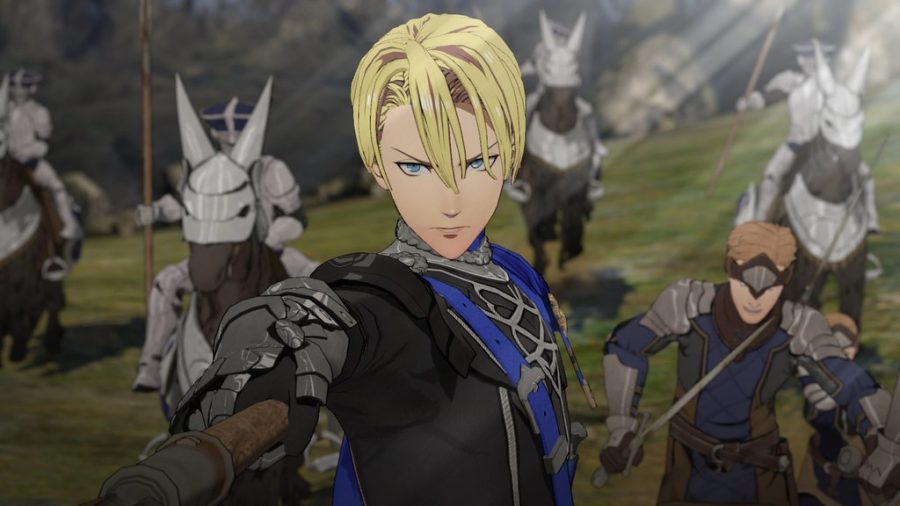“Fire Emblem: Three Houses” and the cultural conflict between Eastern and Western views
Culture can influence and shape how different ideas and identities are shaped and presented. Is it OK for companies to profit off different representations?
June 2, 2021
The latest installment in the “Fire Emblem” series, “Three Houses,” brought controversy to Western audiences because of a game element along with the localization in the game.
Released on July 26, 2019, Nintendo’s official site describes “Three Houses” as a tactical role-playing game. The “Fire Emblem” games contain romance mechanics, with a heavier emphasis on it in recent years. Over the course of later installments in the series, Intelligent Systems has become LGBT inclusive over time. As a result, fans have criticized “Three Houses” because the player character, known as Byleth, has varied romantic pairings with supporting characters. If Byleth’s female variant is selected, you can marry five female characters whereas the male counterpart can marry one male character. Fans claim that if romance is a game element, most characters should be bisexual for players to avoid replaying the game as the opposite sex to marry their favorite characters, but that’s what Western audiences want. What about Japan’s?
In Japan, “queerbaiting,” a marketing technique in which creators hint at, but then do not actually depict, same-sex romance, which is not a problem in their culture, unlike in the West. Eastern cultures like Japan’s have a completely different history surrounding LGBT issues, which is why there are more lesbian relationships present in the media than gay relationships. “LGBT rights in Japan,” a Wikipedia page, states Japan’s history of LGBT rights has always been relatively progressive compared to other countries. The same-sex activity was only criminalized between 1872 and 1880, but Japan’s culture and major religions do not have a past of hostility towards homosexual communities.
Because of Japan’s history of LGBT rights, Eve McGuicken says in her essay “Sex and Sexualization: Japan’s Relationship with Women as Explored Through Its Animation Industry,” “Japan is infamous in western society for the stereotype of oversexualizing women; through several routes but specifically the animation industry – dominated by the male gaze that influences it almost completely.” This attests that if there is a supply, there is a demand because of Japan’s video game fan base.
Human Rights Watch reports “Japanese LGBT children who attempt to report bullying and harassment to school officials play their luck, as the response depends entirely on an individual teacher or school staffer’s personal perspectives on sexual orientation and gender identity. There is no comprehensive training for school staff, and the guidelines that do exist are non-binding suggestions issued in April 2016, which predicate respect and accommodation for gender identity on the diagnosis of a mental disorder.” Japanese culture views LGBT communities as being immature, something that could change over time, resulting in the country’s views as a willingness to be more open in its media than in the Wast.
The localization team for “Three Houses” aimed to be family-friendly to Western audiences, where different types of things are acceptable. The localization company, Treehouse, is mindful of Nintendo’s image of being an age-appropriate company. In Andrew Todd’s article, localization team member, Alison Rapps, is quoted as, “American culture and Japanese culture are just different, and one shouldn’t be expected to imitate the other. GamerGaters believe Nintendo has ‘censored’ the game, but it’s hard to call a private company adapting to the social norms of a new culture ‘censorship’ when the original version can still be imported and nothing has been actually banned. They simply know that the phrase ‘freedom of speech sounds good,’ and just like in cases of feminist criticism, they’ll invoke it whenever they feel like their ability to leer at cartoons is being curtailed.”
For this reason, games like Fire Emblem are changed to be palatable to different cultures. They are often localized based on where the game is sold to depict LGBT communities in different lights. Within Fire Emblem, the same-sex relationships were a fanservice for Japan’s audience, which is the primary audience the company wanted to please. That is where most of the sales are and therefore best for business. Many fans interpret the same-sex relationships Byleth’s male variant that received were out of necessity for the company’s western audiences.
Evidently, many vocal, Western fans of Fire Emblem are part of LGBT communities. As such, these fans interpret characters as representations and even label them as queer-coded through the use of traits and stereotypes recognizable to audiences. Although it is true in some cases, it often miseducates fans about characters and their sexualities. Representation is important, but if representation is out of necessity for Fire Emblem’s western audiences like fans claim, is it better than no representation at all?
In my own opinion, representation is not representation unless a creator wants to incorporate it in their series. The request for same-sex pairings from some audiences for fetishization versus LGBT communities will always be an ongoing conflict with or without confirmed couples. Every day, the media influences our lives and changes how we interpret cultural norms besides our own. The contrast between Western and Eastern acceptance gravitates to how often cultures differ and cannot be translated regionally. Even though the Fire Emblem games are fictional and not based on real-life events, fictional characters influence us in real life and can change your life completely.






